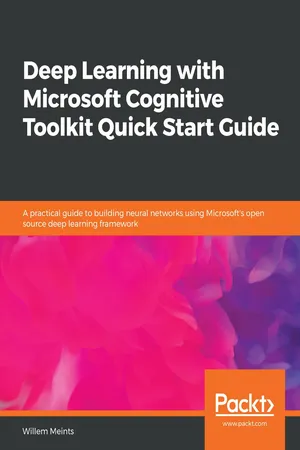
Deep Learning with Microsoft Cognitive Toolkit Quick Start Guide
A practical guide to building neural networks using Microsoft's open source deep learning framework
Willem Meints
- 208 pagine
- English
- ePUB (disponibile sull'app)
- Disponibile su iOS e Android
Deep Learning with Microsoft Cognitive Toolkit Quick Start Guide
A practical guide to building neural networks using Microsoft's open source deep learning framework
Willem Meints
Informazioni sul libro
Learn how to train popular deep learning architectures such as autoencoders, convolutional and recurrent neural networks while discovering how you can use deep learning models in your software applications with Microsoft Cognitive Toolkit
Key Features
- Understand the fundamentals of Microsoft Cognitive Toolkit and set up the development environment
- Train different types of neural networks using Cognitive Toolkit and deploy it to production
- Evaluate the performance of your models and improve your deep learning skills
Book Description
Cognitive Toolkit is a very popular and recently open sourced deep learning toolkit by Microsoft. Cognitive Toolkit is used to train fast and effective deep learning models. This book will be a quick introduction to using Cognitive Toolkit and will teach you how to train and validate different types of neural networks, such as convolutional and recurrent neural networks.
This book will help you understand the basics of deep learning. You will learn how to use Microsoft Cognitive Toolkit to build deep learning models and discover what makes this framework unique so that you know when to use it. This book will be a quick, no-nonsense introduction to the library and will teach you how to train different types of neural networks, such as convolutional neural networks, recurrent neural networks, autoencoders, and more, using Cognitive Toolkit. Then we will look at two scenarios in which deep learning can be used to enhance human capabilities. The book will also demonstrate how to evaluate your models' performance to ensure it trains and runs smoothly and gives you the most accurate results. Finally, you will get a short overview of how Cognitive Toolkit fits in to a DevOps environment
What you will learn
- Set up your deep learning environment for the Cognitive Toolkit on Windows and Linux
- Pre-process and feed your data into neural networks
- Use neural networks to make effcient predictions and recommendations
- Train and deploy effcient neural networks such as CNN and RNN
- Detect problems in your neural network using TensorBoard
- Integrate Cognitive Toolkit with Azure ML Services for effective deep learning
Who this book is for
Data Scientists, Machine learning developers, AI developers who wish to train and deploy effective deep learning models using Microsoft CNTK will find this book to be useful. Readers need to have experience in Python or similar object-oriented language like C# or Java.
Domande frequenti
Informazioni
Validating Model Performance
- Choosing a good strategy to validate model performance
- Validating the performance of a classification model
- Validating the performance of a regression model
- Measuring performance of a for out-of-memory datasets
- Monitoring your model
Technical requirements
cd ch4
jupyter notebook
Choosing a good strategy to validate model performance
Using a hold-out dataset for validation

from sklearn.model_selection import train_test_split
X_train, X_test, y_train, y_test = train_test_split(X, y, test_size=0.2)
Using k-fold cross-validation

What about underfitting and overfitting?
Indice dei contenuti
- Title Page
- Copyright and Credits
- Dedication
- About Packt
- Contributors
- Preface
- Getting Started with CNTK
- Building Neural Networks with CNTK
- Getting Data into Your Neural Network
- Validating Model Performance
- Working with Images
- Working with Time Series Data
- Deploying Models to Production
- Other Books You May Enjoy